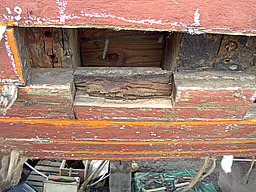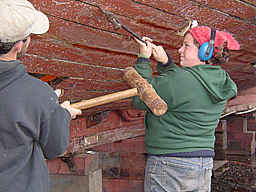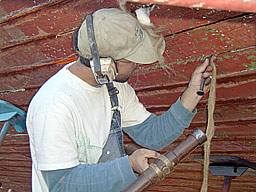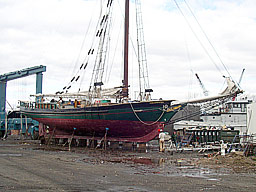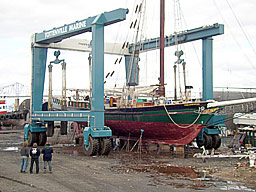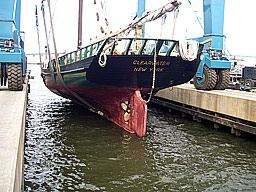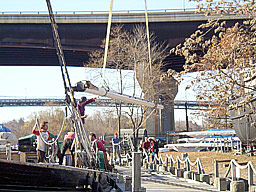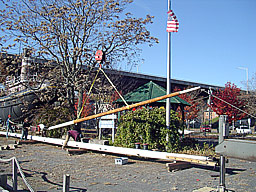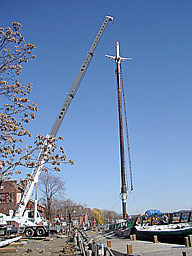
The Clearwater Restoration Project, Main Page
|
Winter 2005-2006 Foredeck, Standing Rigging, Hull Planking and Systems Dear Friends and Shipmates: This winter, the Clearwater will get a new foredeck, new standing rigging, additional hull planking and upgraded systems. As the sloop’s captains, we want to update you on this winter’s work, which is part of our multi-year Sloop Restoration Plan. Foredeck. Thirty-six years and hundreds of thousands of pairs of young and old feet have worn away 1/2" to 3/4" of the thickness of the deck planks. The surface is gouged and uneven—no longer suitable passengers and weakening the boat’s structural “girder”. We’ve been drying 780-square feet of rare longleaf yellow pine and white oak for the new deck. Skilled shipwrights, carpenters and caulkers stand ready to take up traditional sloop building tools and move through the painstaking steps of shaping and fitting the new deck and covering boards into place, caulking the seams with cotton and oakum, then “paying” them with pitch. The foredeck project will be our single largest restoration project to date, costing more than $150,000 for direct labor and materials. Standing Rigging. At nearly 3,000 square feet, Clearwater’s mainsail is one of the three largest mainsails in North America. Our jib, with another 1,000 square feet, balances the rig fore and aft, and keeps us sailing straight. This extensive sail area creates incredible strain on the bowsprit and mast. The 68' boom alone weighs nearly 1,500 pounds. Clearwater’s powerful standing rigging bears most of the strain. Installed at its launch in 1969, it is also being replaced this winter. The shrouds and stays of the rigging are made up of six strands of 19 galvanized wires each. The rigging supports the mast and other spars, such as the bowsprit and topmast—which, despite their size, would easily fracture without support. A technique called “serving” protects the wire rope from rusting, using tools and technologies unchanged for two centuries. Marline is “wormed” into the wire’s grooves. Then cotton or “parcel” soaked in pine tar is wrapped around the wire with the lay. Finally more marline is spun or served in the opposite direction. The old saying, “worm and parcel with the lay, turn and serve the other way” has been passed along from rigger to boatswain to sailor for years as a way to remember the proper direction to do the traditional work. Serving, however, also makes the underlying wire rope invisible to inspection. The serving may conceal weaknesses that would otherwise be manifest by raised broken strands of wire or obvious wear at the ends where shackles and eyes are attached. Planking. As a ship flexes in response to wind and wave, its planks move back and forth against each other. This action spits out the caulking and opens the planks to erosion and decay. In recent winters, leaks—perhaps due to ice damage from long, hard freezes—have accelerated the number of Clearwater’s planks requiring immediate attention. To catch up, and going forward, we are planning for annual haul-outs to replace heavily ice-worn and eroded planks. This year alone, we hope to replace six hull planks. Most of the methods used in the 19th century are still used today to plank the Clearwater. There are few shortcuts. Thickness planers and large stationary circular saws rough-size a plank. Then hand planes—augmented by power planers—shape each plank to the opening. Next, shipwrights painstakingly fit each plank, often requiring several tries, lifting it up and pulling it down by hand. Old top mauls and pin mauls drive home the fasteners, and wooden plugs—cut from plank stock for consistency—cover the fasteners. Many of the hand tools we use actually date to the 19th century. Systems. Over the years, Clearwater has ended up with a patchwork of improvised electrical and plumbing systems. While less glamorous than replacing her decks or rigging, upgrading her systems is nevertheless critical and long overdue. While the foredeck is off this winter, we will rewire the vessel from stem to stern. We will replace the antiquated Lister generator that supplies power to run the fire and emergency bilge pump. We will also purchase a new fire emergency pump and upgrade the plumbing that supports the pump. It’s going to be an exciting winter! We’ll be sure to keep you posted on opportunities to come out to Saugerties to observe a fascinating chapter in the Clearwater’s history. We think you’ll find the historic techniques and tools used to rework the deck fascinating. In the spring, you’ll also be able to join us for the Clearwater’s re-rigging. We can’t do it without you! Thanks to your generous support, since launching Clearwater’s Restoration Plan four years ago, we’ve raised $700,000 of the nearly $2 million needed to restore it and keep it seaworthy for another Clearwater Generation. To date, we’ve replaced the afterdeck, cabin top, boom, mainsail, jib and propeller shaft. Last winter we replaced 13 planks and six frames and installed a winter heating system to keep ice that can damage planks from the bilges. But we still have a long way to go to make Clearwater ready for another 35 years. Please be generous with your winter gift to the sloop. Your loyal support has kept Clearwater sailing for nearly four decades now, and we are counting on you to help keep it shipshape, safe and working to protect America’s environment. With best wishes and gratitude,
|
|
